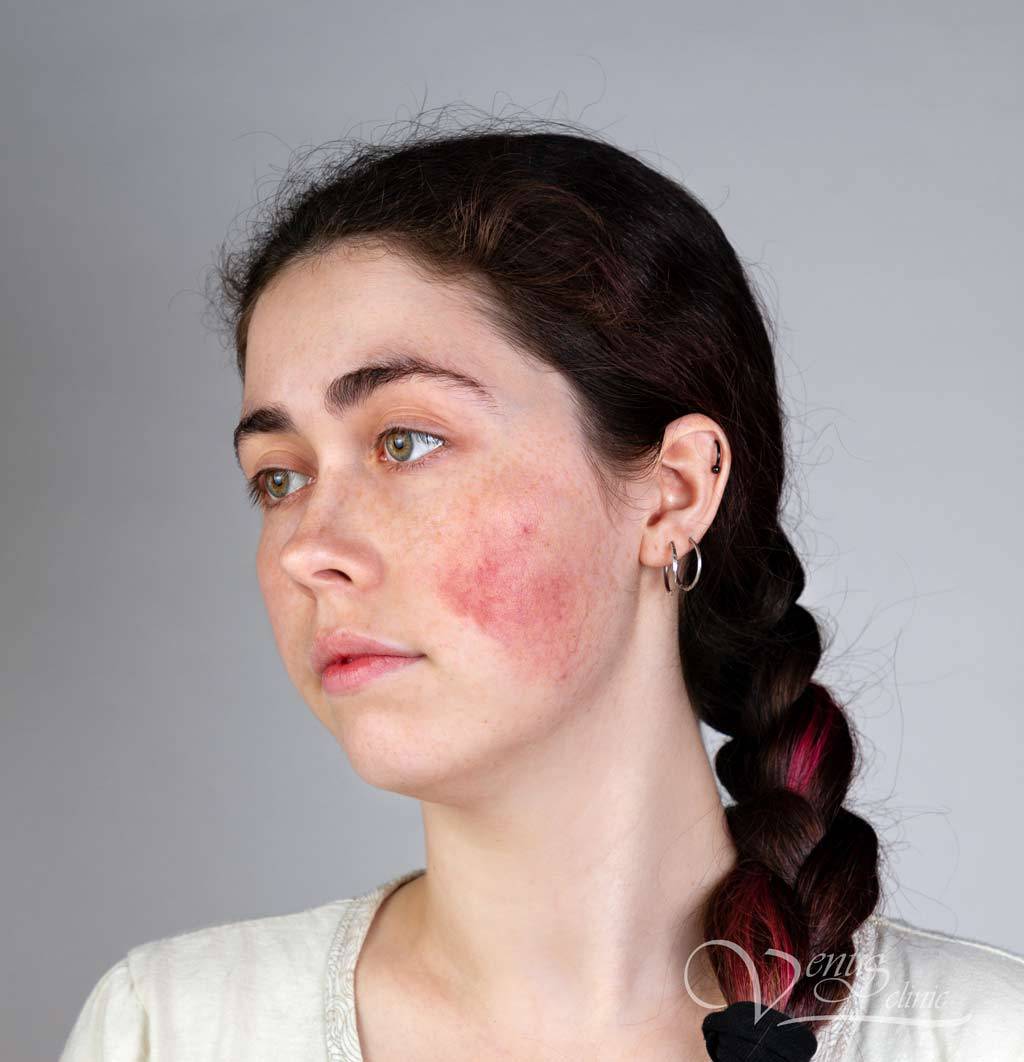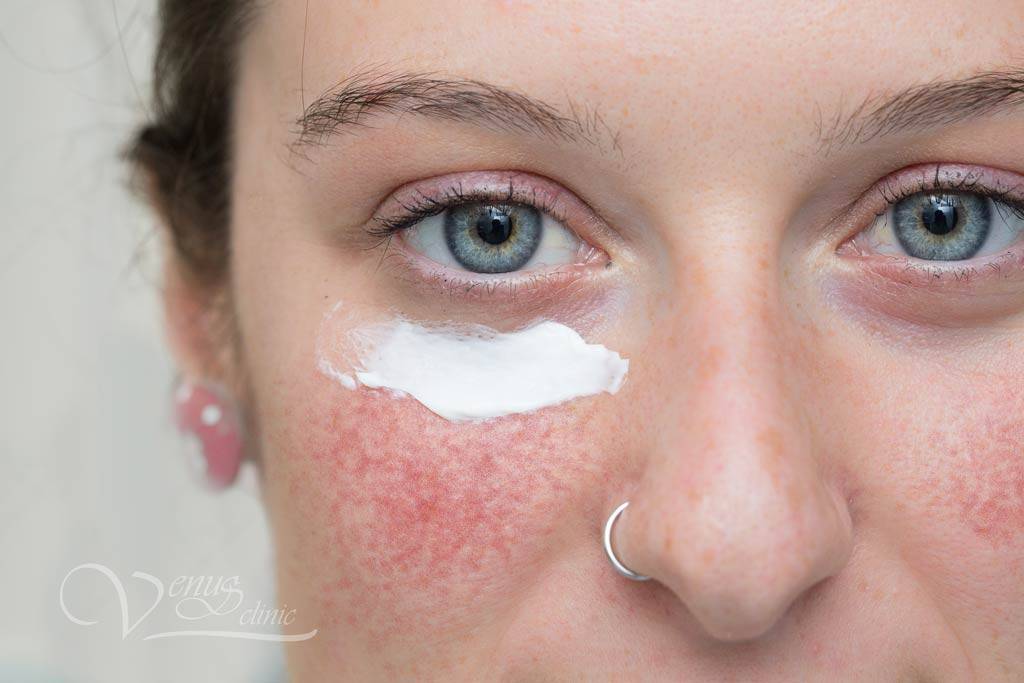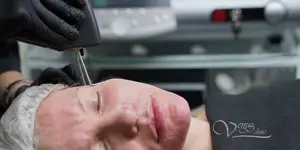
Top 10 causes of cuperosis, treatment and prophylaxy
Cuperosis is a dermatological pathology characterized by the appearance of redness, irritation and small dilated capillaries on the face. The concept of cuperosis is a non-medical term and originates from cuper - copper, as the face becomes copper-colored due to dilated capillaries.
Is Cuperosis dangerous?
Cuperosis, or rather telangiectasia, is a benign vascular tumor in which changes occur in the walls of blood vessels. This leads to vasodilation and they become visible to the naked eye. We hasten to reassure you, despite the fact that this is a vascular tumor, it is not life-threatening, but it causes a lot of anxiety and psycho-emotional discomfort for patients.
How does cuperosis appear?
Facial flushing is sometimes normal. It is normal when we go in for sports due to cold weather. Under normal conditions, dilated capillaries narrow and the skin has a natural color. But when the vessels become noticeable constantly and increase over time, we are talking about cuperosis.

The appearance of blood vessels on the face is caused by a change in the microcirculation of blood in the capillaries that nourish the cells of the skin of the cheeks, nose and chin.
These small vessels have very low elasticity. Therefore, under the influence of factors that cause periodic contractions and vasodilation, they eventually lose their ability to narrow and we see the result - dilated vessels on the face.
Symptoms of cuperosis
The main symptom of cuperosis is redness of the skin, which occurs throughout the area due to an increase in blood flow that occurs when venules and arterioles expand. These small vessels, losing elasticity, eventually dilate without returning to their normal size.

Over time, telangiectasias are added to the dilated capillaries on the face - small red or purple veins that are visible through the skin as threads or branching threads in the form of a spider web (vascular mesh).
Causes
As we have already mentioned, rosacea is a pathology that occurs due to a violation of microcirculation, in which the blood vessels remain dilated, so any factor that causes vasodilation can be the cause of rosacea in predisposed people.
10 causes of cuperosis
- Sudden temperature changes: Temperature fluctuations cause capillaries and blood vessels to contract and expand. If they are sharp and frequent, then they can lead to a loss of elasticity of blood vessels.
Strong heat, wind, cold, work in the sun, in hot workshops, a cook in the kitchen, etc.: all these weather and household factors contribute to vascular changes. - Skin rashes or persistent minor injuries to the skin can also cause the appearance and persistence of redness.
- Smoking, because, among other harmful effects on your health, it affects microcirculation, causing skin vasodilation. This leads to the growth of existing vessels and the emergence of new ones. In smokers, the pathology progresses faster.

- Excessive alcohol consumption also leads to circulatory problems.
- Applying irritating products to the skin, whether they are in cosmetics such as soaps, scrubs, creams, high chlorine or very lime water, etc.
- Exposure to ultraviolet rays from sunlight or UV lamps. Ultraviolet light damages both the skin, causing it to thin, and the walls of blood vessels. If there are already dilated vessels, then their contact with ultraviolet light will aggravate the situation.
- Stress, nervous disorders or strong emotions also dilate blood vessels, which sooner or later will lead to a loss of elasticity of the vascular wall and vasodilatation.
- Hot, spicy foods and drinks dilate blood vessels.
- Circulatory pathologies such as hypertension and diabetes.
- Hormonal changes: pregnancy, menopause, menstrual irregularities, etc.
Who has more common cuperosis?
Cuperosis of the face is more common in people with fair, thin and sensitive skin, as this type of skin is more reactive and naturally blushes easily.
Cuperosis affects women more often than men and, in addition, there is a genetic predisposition to this disease, that is, it is inherited.
Treatment
We hasten to please you, today the treatment of cuperosis is not a problem. There is a wide range of cosmetic and laser techniques that allow you to get rid of dilated blood vessels on the face, as well as to act on the causes that cause them so that the signs of cuperosis do not progress in the future.
A dermatologist is involved in the treatment of rosacea. In our clinic, you will undergo hardware diagnostics of the face, which will allow you to see the already existing and hidden dilated vessels. Depending on this, the method and scope of the treatment will be chosen.
Vascular Laser Removal is the most effective and efficient way to get rid of dilated blood vessels. The laser beam selectively "glues" pathologically dilated vessels without damaging healthy skin cells. The results are visible after the first treatment. Usually 1 to 3 treatments are required with an interval of 10-14 days. It is absolutely safe for the skin and the body as a whole.

SensiPeel peeling for sensitive skin. Often, rosacea on the face is a consequence of cuperosis. A sensitive skin exfoliation will help normalize the skin's protective barrier, reducing the symptoms of rosacea. This will improve the condition of the skin and prevent future rosacea patients from developing cuperosis.
Skin peeling. In the case when there are signs of wilting and one of the causes of rosacea is thinning of the skin, as a result of which the vessels become more visible, a good solution would be the mid-surface peeling MD Peel from the leading American manufacturer of peeling PCA Skin. It is recommended to combine peeling with BBL photorejuvenation. The course of photorejuvenation will get rid of unwanted blood vessels, and peeling will restore skin elasticity by stimulating collagen synthesis. This is the treatment of an existing problem and the prevention of its reappearance.
Facial diagnostics in our clinic will help not only determine the scope of the procedure, but also evaluate the results of treatment. This is an important stage of treatment, because it allows you to be one step ahead and prevent the appearance of new dilated vessels even at the stage of their appearance, when small capillaries are hardly visible to the naked eye. Which will save time and money.
Prophylaxy
To prevent cuperosis, you should avoid the factors that cause it.
There is a false opinion that it is necessary to get a tan to hide the vessels under the tan. Yes, tanning masks dilated blood vessels, but ultraviolet light causes irreversible damage to the skin and aggravates the situation with blood vessels, causing an increase in existing ones and the appearance of new ones. It is important to avoid sun exposure without sunscreen.

Also, avoid toxins such as alcohol and tobacco, and eat a healthy diet rich in antioxidants and vitamins, such as fruits and vegetables. If your skin is frequently exposed to adverse weather conditions, then choose cosmetics that are most suitable for your climate and your skin type. The task of cosmetics is to provide comfort for the skin and protect it from adverse environmental factors.
Skin Care Tips
First of all, remember to consult your doctor. A dermatologist will determine your skin type and current skin condition.

The skin is dynamic, its condition can change depending on the care, climate, your diet and lifestyle. Therefore, it is important not only to understand your dry, normal, oily or combination skin, but also its current condition. The skin can be oily but dehydrated (when the skin loses excess moisture). At first glance, incongruous conditions, but this often happens with the wrong home care. The skin loses its ability to withstand adverse environmental factors and becomes vulnerable to external stimuli.
The doctor will help you choose cosmetics for home care, depending on the individual characteristics and needs of your skin. This will be the key to the success of the laser treatment of cuperosis.

There are various cosmetics that reduce the manifestations of rosacea:
- Cleanse your skin twice a day with mild cleansers: micellar water, soap without harsh detergents (such as PCA Skin Creamy Cleanser), thermal water, etc. Avoid products that need to be rinsed off with water.
- Use moisturizers according to your skin type and condition, which contain active ingredients that moisturize and soothe skin irritations.
- Do not use scrubs or chemical peels on your own, which can further irritate the skin. If necessary, you can use an enzyme peel, which is softer on delicate skin.
- Always, daily, protect yourself from the sun. Sunscreen should also be applied in winter and cloudy weather. It is enough to use SPF 30.
- Use dietary supplements with antioxidants and omega-3, omega-6, omega-7 fatty acids that will protect and nourish your skin from the inside out. Damage to blood vessels occurs under the influence of free radicals, which appear under the influence of adverse environmental factors.
- GliSODin Anti-age - for dry, aging and sensitive skin. The action is aimed at the aging process in order to support and protect against adverse external factors.
- GliSODin Brightening - if you have light, sun-sensitive skin, sun allergies and photodermatosis.

By following these simple tips, you can prevent the progression of rosacea and keep your skin healthy and beautiful.











